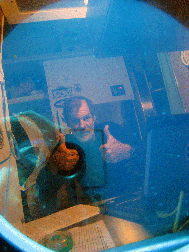Aquarius Saturation Mission 2008

Coral reef restoration sometimes requires that corals are transplanted from a donor site to a disturbed site. The origin of the donor corals maybe natural, e.g. a storm may have generated fragments by breaking colonies. Or, such donor corals may come from coral nurseries to repopulate an area that was denuded by some disturbance such as a ship grounding or through anchor damage. Do wild and nursery raised corals have the same chance of survival when transplanted? How far from their native site can one move coral fragments without decreasing their chance of survival or impacting the genetic population structure of the species? The current saturation mission in the Aquarius underwater habitat is designed to answer these and other questions.

We understand little of what determines the performance (e.g. growth rate, reproductive output) of a coral colony. The genetic makeup of the animal itself may play a role. Also, because corals live in a tight symbiosis with microscropic algae (zooxanthellae), the type of symbionts the colony harbors may influence its survival. How do we find out whether some coral genotypes are better adapted to certain environments? Do all species of corals respond equally to transplantation? In this experiment, we are taking advantage of the ability of coral colonies to survive fragmentation. We are working with two species: the delicate branching staghorn coral, Acropora cervicornis and the massive mounding star coral, Montastraea faveolata. The donor colonies come from several sources, both wild and nursery-raised. Each coral genotype is split into two smaller fragments. We then transplant one of the fragments to a shallow site (around 30 ft), and the other to a deep site (around 60ft). By raising all these colonies in a "common garden", we can directly compare their performance over time. This will help us understand how to design and implement future reef restoration efforts. Also, more fundamentally, it may shed light on how much individual variation there is in coral populations to withstand stressful periods (transplanting is stressful for coral…). We need such estimates of variability in coral stress response to better predict the fate of corals in the face of global warming.


This is a massive experiment. On land, we could take our time and carefully execute the collection, labeling, measuring, fragmenting, transplanting and re-measuring of the several hundred colonies. Underwater, things are different. We are time limited! So, instead, we are taking advantage of NOAA’s underwater habitat: the Aquarius in the Florida Keys. Four of our colleagues are living underwater in something akin to a space station for eight straight days. This allows them to dive for six hours a day at 60ft. Margaret and I are supporting the mission topside by supplying them with the colonies they need to transplant. Also, because the aquanauts cannot ascend higher the 40ft, Margaret and I are transplanting all the fragments to our shallow site. What an experience!